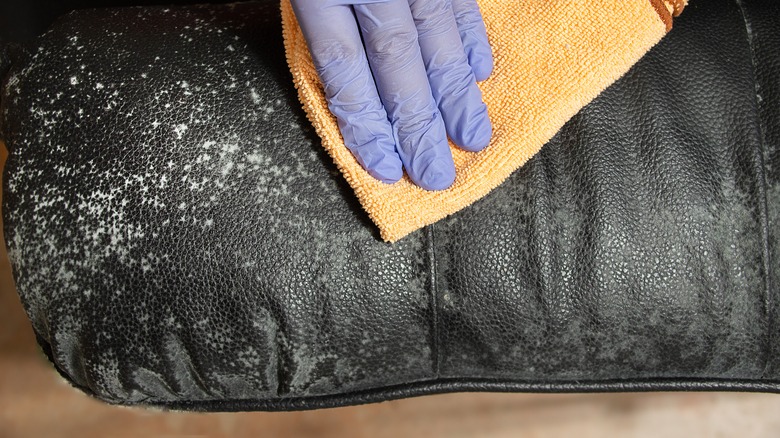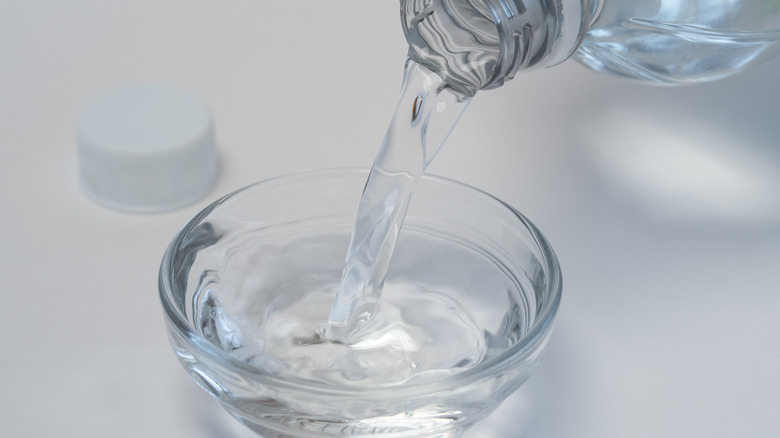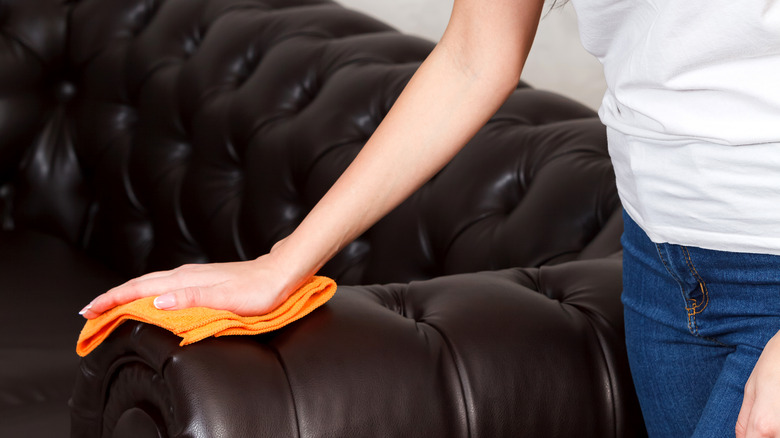The Household Essential That'll Save Your Moldy Leather Furniture
We may receive a commission on purchases made from links.
If you live in a climate with a fair amount of humidity, as well as using a dehumidifier, you'll want to monitor moisture-prone areas of your home for possible mold growth — like your bathroom. But, the last place you want to see it show up is on your beautiful leather sofa. While you'll need to engage in a whole multi-step cleaning procedure, the secret ingredient to getting mold off your leather furniture is to use distilled white vinegar mixed with distilled water, which has a neutral pH. The great advantage of vinegar is that it's antifungal, antibacterial, and a disinfectant.
Aside from the obvious aesthetic reason to remove mold, you need to immediately kill it off because it poses a serious health risk to everyone in your home, humans and pets alike. The State of Rhode Island's Department of Health blog reminds us that mold causes extreme fatigue, labored breathing, headache, runny eyes, and runny nose. And, according to mold remediation company MoldTech, the symptoms in pets are similar, and they may vomit too. Certain strains of mold cause mycotoxins which can lead to serious illnesses along with immunological, neurological, and other disorders.
How to carefully use vinegar to remove mold from leather
Leather furniture is a heck of an investment. You'll want to first do a color test using a one-to-one ratio of vinegar diluted with distilled water on a hidden part of the fabric. Apply it very lightly, allow it to dry, then assess the color before proceeding. Once you feel secure that the vinegar solution won't discolor the leather, you can get started.
The supplies you'll need include a clean toothbrush, a few drops of fragrance, dye, and additive-free mild dishwashing soap in a small bowl of distilled water, four clean microfiber or old t-shirt cloths (or a couple of sponges and two cloths), and a clean spray bottle containing a cup of vinegar mixed with one cup of distilled water. It's also handy to have your vacuum cleaner standing by.
With a soft nylon toothbrush, brush off the mold and then vacuum the furniture and surrounding floor right away. Dip your sponge or cloth in soapy water and make sure to wring it out – don't use a wet cloth — and rub the spot. Immediately use another cloth to dry the area. Once dry, spray a clean cloth with the vinegar solution and use the same light-handed technique, wiping the spot and then immediately drying the area afterward. Buff the area with a conditioner suitable for leather furniture like Chemical Guys Leather Cleaner, from Amazon.
A few extra tips
If at all possible and the humidity is low, clean the furniture outside. This is easier if it's just a cushion, but it's important because you don't want to spread mold spores inside your home. Of course, don't leave a leather sofa sitting in the middle of your lawn unattended while it dries! But whether you work indoors or out, always protect your lungs from mold by wearing a mask and gloves while cleaning. Additionally, use a disposable toothbrush, then once you're done, wrap it in plastic wrap and carefully discard it.
Another important note is to assess how deep the mold goes. If the mold has been allowed to flourish and grow for years, it may have infested the foam cushions or any materials underneath the leather. If a moldy smell persists after you've completed this cleaning process and everything has dried, we recommend you reach out to a professional leather furniture expert to discuss your next steps.


